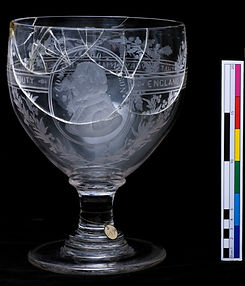
Admiral Lord
Nelson Rummer
Norfolk Museums, Norfolk, UK
One of my treatment projects in graduate school was this beautiful glass rummer depicting the complicated British war hero Admiral Horatio Lord Nelson. It was commissioned after his death at the Battle of Trafalgar in 1805 (before treatment, left).
The treatment of the glass was started by a previous student, but the epoxy used failed to cure. It was my task to dismantle the broken glass and reassemble it with a more conservation-grade adhesive.
See below for more details of my treatment process. Or click here to access the full treatment report.
Before Treatment (2013)
The glass had been repaired in the past using an epoxy resin that yellowed with exposure to UV light and did not match the refractive index of the glass. The cracks were very visible and the yellowed historic fill stood out

Before Treatment (2014)
Some pieces remained together, but the rest of the glass was actively falling apart. Remnants of partially-cured epoxy covered the interior of the bowl





Treatment Process
I dry-fit the glass with tiny pieces of tape placed on the outside of the vessel. I dotted HXTAL along the joins on the inside of the rummer to prevent the epoxy from flowing under the tape. I first joined the two large halves of the bowl (B). Then the rest of the bowl was joined all at once. To further stabilize the heavy glass during the week-long curing process, I wrapped the exterior of the rummer in Parafilm (C).
I filled a large area of loss around the rim with HXTAL (in-progress, D). The resin was built up in layers against a Tiranti Silicone Mould Material backing. The final surface was polished with successive layers of MicroMesh and plastic polish. Finally, I painted a thin layer of HXTAL over the top to replicate the glossy surface.

A

B

C

D




